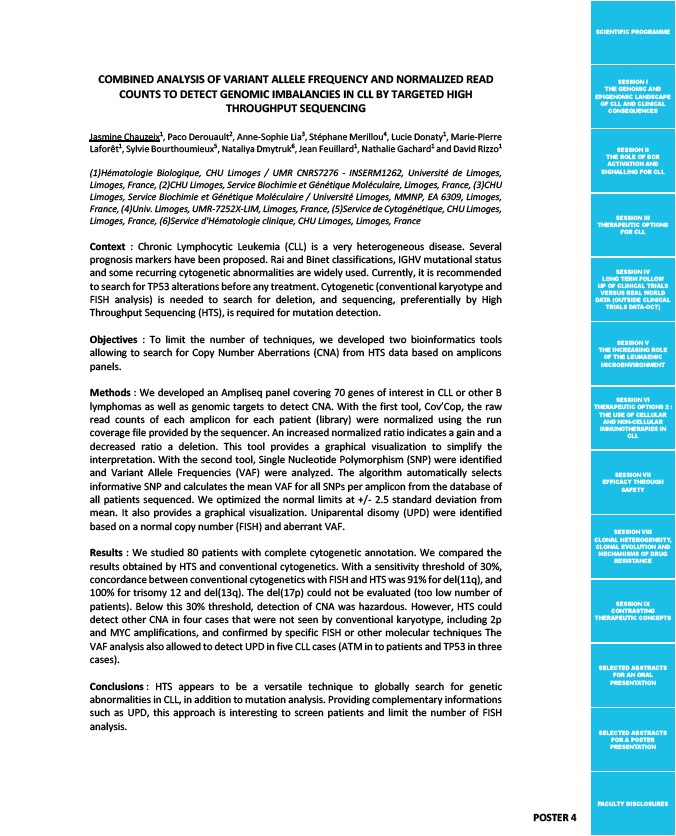
SCIENTIFIC PROGRAMME
SESSION I
THE GENOMIC AND
EPIGENOMIC LANDSCAPE
OF CLL AND CLINICAL
CONSEQUENCES
SESSION II
THE ROLE OF BCR
ACTIVATION AND
SIGNALLING FOR CLL
SESSION III
THERAPEUTIC OPTIONS
FOR CLL
SESSION IV
LONG TERM FOLLOW
UP OF CLINICAL TRIALS
VERSUS REAL WORLD
DATA (OUTSIDE CLINICAL
TRIALS DATA-OCT)
SESSION V
THE INCREASING ROLE
OF THE LEUKAEMIC
MICROENVIRONMENT
SESSION VI
THERAPEUTIC OPTIONS 2 :
THE USE OF CELLULAR
AND NON-CELLULAR
IMMUNOTHERAPIES IN
CLL
SESSION VII
EFFICACY THROUGH
SAFETY
SESSION VIII
CLONAL HETEROGENEITY,
CLONAL EVOLUTION AND
MECHANISMS OF DRUG
RESISTANCE
SESSION IX
CONTRASTING
THERAPEUTIC CONCEPTS
SELECTED ABSTRACTS
FOR AN ORAL
PRESENTATION
SELECTED ABSTRACTS
FOR A POSTER
PRESENTATION
FACULTY DISCLOSURES
COMBINED ANALYSIS OF VARIANT ALLELE FREQUENCY AND NORMALIZED READ
COUNTS TO DETECT GENOMIC IMBALANCIES IN CLL BY TARGETED HIGH
THROUGHPUT SEQUENCING
J
asmine Chauzeix1, Paco Derouault2, Anne-Sophie Lia3, Stéphane Merillou4, Lucie Donaty1, Marie-Pierre
Laforêt1, Sylvie Bourthoumieux5, Nataliya Dmytruk6, Jean Feuillard1, Nathalie Gachard1 and David Rizzo1
(1)Hématologie Biologique, CHU Limoges / UMR CNRS7276 - INSERM1262, Université de Limoges,
Limoges, France, (2)CHU Limoges, Service Biochimie et Génétique Moléculaire, Limoges, France, (3)CHU
Limoges, Service Biochimie et Génétique Moléculaire / Université Limoges, MMNP, EA 6309, Limoges,
France, (4)Univ. Limoges, UMR-7252X-LIM, Limoges, France, (5)Service de Cytogénétique, CHU Limoges,
Limoges, France, (6)Service d'Hématologie clinique, CHU Limoges, Limoges, France
Context : Chronic Lymphocytic Leukemia (CLL) is a very heterogeneous disease. Several
prognosis markers have been proposed. Rai and Binet classifications, IGHV mutational status
and some recurring cytogenetic abnormalities are widely used. Currently, it is recommended
to search for TP53 alterations before any treatment. Cytogenetic (conventional karyotype and
FISH analysis) is needed to search for deletion, and sequencing, preferentially by High
Throughput Sequencing (HTS), is required for mutation detection.
Objectives : To limit the number of techniques, we developed two bioinformatics tools
allowing to search for Copy Number Aberrations (CNA) from HTS data based on amplicons
panels.
Methods : We developed an Ampliseq panel covering 70 genes of interest in CLL or other B
lymphomas as well as genomic targets to detect CNA. With the first tool, Cov’Cop, the raw
read counts of each amplicon for each patient (library) were normalized using the run
coverage file provided by the sequencer. An increased normalized ratio indicates a gain and a
decreased ratio a deletion. This tool provides a graphical visualization to simplify the
interpretation. With the second tool, Single Nucleotide Polymorphism (SNP) were identified
and Variant Allele Frequencies (VAF) were analyzed. The algorithm automatically selects
informative SNP and calculates the mean VAF for all SNPs per amplicon from the database of
all patients sequenced. We optimized the normal limits at +/- 2.5 standard deviation from
mean. It also provides a graphical visualization. Uniparental disomy (UPD) were identified
based on a normal copy number (FISH) and aberrant VAF.
Results : We studied 80 patients with complete cytogenetic annotation. We compared the
results obtained by HTS and conventional cytogenetics. With a sensitivity threshold of 30%,
concordance between conventional cytogenetics with FISH and HTS was 91% for del(11q), and
100% for trisomy 12 and del(13q). The del(17p) could not be evaluated (too low number of
patients). Below this 30% threshold, detection of CNA was hazardous. However, HTS could
detect other CNA in four cases that were not seen by conventional karyotype, including 2p
and MYC amplifications, and confirmed by specific FISH or other molecular techniques The
VAF analysis also allowed to detect UPD in five CLL cases (ATM in to patients and TP53 in three
cases).
Conclusions : HTS appears to be a versatile technique to globally search for genetic
abnormalities in CLL, in addition to mutation analysis. Providing complementary informations
such as UPD, this approach is interesting to screen patients and limit the number of FISH
analysis.
POSTER 4